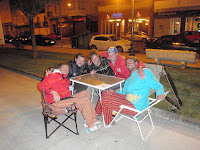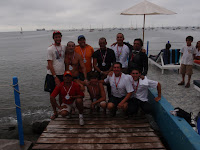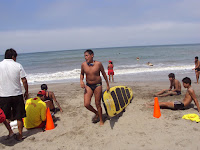Leaving Spain and arriving in Morocco, I’ve been caught in deep thought about the nature of the Strait of Gibraltar, or the border that separates these two countries. Much of this has been self provoked, which makes sense given that I’m embarking on a three month long adventure into the depths of cultural difference between myself and my friends from each country, and yet what I find is that while I’m actively looking for what makes us different, the peaceful side of me tends to come out as I consistently say “This isn’t so different from home, or Spain, or Morocco, or elsewhere”. Some things are different, however, and to begin lightly, let’s start on the superficial level. The deeper stuff will come out in the next few weeks.
I took the ferry from Tarifa to Tanger, crossing the 15km of the Strait of Gibraltar that I had swum 7 months previously. I was more sentimental about the experience than I had imagined, and spent much of the boat ride simply looking at the water and remembering how I felt at different times during my three and a half hour crossing. Arriving on the coast, the distinct smells and sounds were what first struck me as I left the ferry for the streets of Tanger. By this time, I had dropped my luggage off at the bus station, and was able to enjoy a few hours of the exploring the city, which mostly consisted of sitting on a bench in a plaza and drinking tea at a café, which is a very traditional way for Moroccan men to spend an afternoon.
One of the first scents that reminded me of my arrival in Morocco was the pungent body odor of many Moroccan men. It is a concentrated secretion of pheromones, and the smell is strong and bitter. To tell you the truth, I’ve never been one to dislike the smell of body odor; from California hippies, to the French, to Moroccans, each group has a distinguishing smell, and I much prefer this to the very uninteresting and usually chemical warning smell of colognes. I had a biology professor in college that told me of an experiment done where women were asked to smell the tee-shirt worn by various men, who slept in the shirt without having used deodorant or cologne. The women were then asked to rank the smells on a scale of who they would prefer to have children with. Later, DNA analysis were done to compare genetic compatibility between the women and the men they had chosen simply based off of the tee-shirt smell, and something like 99% of the time, the women choose the man they were most genetically compatible with (in terms of healthy offspring).

Awesome fish market in Tanger
Aside from the sounds of drinking tea, there are a few other distinguishing Moroccan tunes. The first is the language, full of consonants and deep throat resonances. More than simply being Arabic (or Berber, depending on where you are or who you are with in Morocco), it is the way people talk that really makes the difference. Many would say that it sounds like people are always angry in Morocco; that they are always screaming at each other. Granted the normal conversation tends to be loud and it can be interpreted as a heated discussion, my experience among friends here, who care deeply for each other and yet often yell and wave their hands in normal conversation, has taught me that this harshness in voice and jest is simply cultural and has little to do with anger. I would consolidate this intricacy in saying that Moroccans are very energetic when they speak, and that they also have a lot to say.
The call to prayer is an obvious melody that appears on scene once arriving in Morocco.
When I was living in Sana’a, Yemen, however, there was a mosque every 200 meters, and hearing the call to prayer in Morocco seems somewhat faint and less powerful than the mostly uncoordinated and unavoidable call of 20 mosques in any vicinity of the old quarter in Sana’a. But this call to prayer in Morocco is similar in that it is an equally uncoordinated call of two or three mosques, but with an uninterested reaction of most people.
And last of all, although this is in no way a comprehensive list of sounds and smells that distinguish Morocco from its neighboring country of Spain, is the constant harassment of street vendors. You don’t really get this in Spain, or if you do, you can usually ignore it because it isn’t all that constant. In Morocco, however, it begins as soon as you get off the ferry where there are bunches of taxi drivers waiting to give you a ride to your next destination. They also offer to act as tour guides, and they know of the best restaurants and hotels in town. Most also speak enough of every European language so as to communicate all of these unknown needs in your native language. If you make it past this first barrage without getting sucked in, then your next challenge is to walk through the streets without getting phased by the offers of souvenirs, food, tea, spices, hash, hotels, guides, ext. And if you show any interest in any of the aforementioned items, you’re a goner, because you’ll be followed for at least half a city block. My experience has been that street hustlers usually begin with the typical items such as restaurants or hotels, and then slowly digress to things like spices and clothing, and after throwing in a few random articles or no desire, they end with “chocolate” aka hash. When you give the final no, they shrug their shoulders, wish you a good day, and walk away.
Swimming in Galicia, Spain, between rocks and a small waterfall
Morocco. I think that if I were placed in Morocco unknowingly, with my eyes closed and no sense of direction, but were given a combination of any two of these smells or sounds, I would know where I was. Granted these are ally stereotypes, and I apologize for resuming an entire country into a discrete set of observations, but this is exactly what these are; distinctions a traveler notices when crossing the Strait of Gibraltar from Spain to Morocco.



































